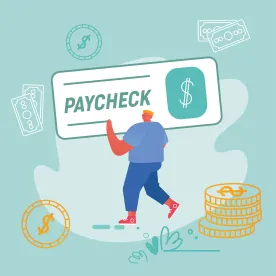The U.S. Department of Treasury (Treasury) and U.S. Small Business Administration (SBA) issued further interpretative guidance on the Paycheck Protection Program (PPP), as enacted under the Coronavirus Aid, Relief, and Economic Security Act (CARES Act), via (i) an updated Frequently Asked Questions fact sheet (FAQ)[1], which was last published on May 6, 2020 and (ii) the distribution of the Eighth Interim Final Rule[2] on May 5, 2020.[3]
Prior to the updated FAQ, SBA guidance provided that a business that applied for a PPP loan before April 24, 2020 and repays the loan in full by May 7, 2020 will be deemed by the SBA to have made the required “economic uncertainty” certification (i.e. the certification that the “[c]urrent economic uncertainty makes this [PPP] loan request necessary to support the ongoing operations of the [a]pplicant”) in good faith, providing a safe harbor amnesty for businesses that timely prepay their loans. The updated FAQ adds Question #43, extending the amnesty prepayment date from May 7, 2020 to May 14, 2020. In doing so, the SBA states that it intends to provide additional guidance prior to May 14 as to “how” it will review the certification. For further analysis on the “economic uncertainty” certification and the corresponding SBA guidance issued thus far, please visit our article on the subject matter.
The updated FAQ also adds Question #44, which states that for purposes of the employee-based size standard, PPP applicants must count “all of its employees and the employees of its U.S. and foreign affiliates” (emphasis added), absent a waiver of or an exception to the applicable affiliation rules. Question #44 is in apparent conflict with both Part 2(a) of the First Interim Final Rule and Question #3 of the FAQ, which provide that a business is eligible for a PPP loan if the business has “500 or fewer employees whose principal place of residence is in the United States” (emphasis added). For purposes of determining a business’s eligibility for a PPP loan pursuant to Part 2(a) of the First Interim Rule and Question #3, affiliation would be determined by counting employees of the business’s U.S. and foreign affiliates, but only those employees that have their principal place of residence in the U.S. Moreover, Question #33 adds that PPP applicants and lenders may consider IRS regulations when determining whether an individual employee’s principal place of residence is in the U.S. Question #44 could have indicated that it was intended to override or clarify Part 2(a) of the First Interim Rule, Question #3 and Question #33, but instead it is silent on that point.[4] Instead, Question #44 (released a month after the First Interim Final Rule and Question #3) injects uncertainty into the affiliation analysis by stating that the applicant “must count all of its employees and the employees of its U.S. and foreign affiliates” – does Question #44 override the First Interim Rule’s and Question #3’s limitation of the employee count to employees whose principal place of residence is in the U.S. or does it merely confirm that the employee count of a PPP applicant must include its foreign affiliates?[5] The SBA may issue further clarifying guidance in the days to come.
Additionally, the SBA’s Eighth Interim Final Rule confirms, among other matters, that (i) generally, student workers count as employees for purposes of the employee calculation for a PPP applicant (subject to certain identified exceptions) and (ii) with respect to any loan or loan forgiveness under the PPP, the nondiscrimination provisions in the applicable SBA regulations incorporate the limitations and exemptions provided in corresponding Federal statutory or regulatory nondiscrimination provisions for sex-specific admissions practices at preschools, non-vocational elementary or secondary schools, and private undergraduate higher education institutions under Title IX of the Education Amendments of 1972 (20 U.S.C. 1681 et seq.), for sex-specific emergency shelters and coreligionist housing under the Fair Housing Act of 1968 (42 U.S.C. 3601 et seq.), and for adoption or foster care practices giving child placement preferences to Indian tribes under the Indian Child Welfare Act of 1978 (25 U.S.C. 1901 et seq.).
*Things are changing quickly and the measures and interpretations described here may change. Our analysis is necessarily limited by the time sensitivities of the current crisis as well as the absence of precedent for some of what is contained here. This analysis represents our best interpretation and recommendations based on where things currently stand.*
Footnotes
[1] The FAQ does not carry the force and effect of law independent of the CARES Act and regulations on which it is based.
[2] The Eighth Interim Final Rule is effective without advance notice and public comment because Section 1114 of the CARES Act authorizes SBA to issue regulations to implement the PPP without regard to notice requirements.
[3] The FAQ and Eighth Interim Final Rule is supplemental to the (i) First Interim Final Rule issued by the SBA on April 2, 2020, (ii) Second Interim Final Rule issued by the SBA on April 3, 2020, (iii) Third Interim Final Rule issued by the SBA on April 14, 2020, (iv) Fourth Interim Finale Rule issued by the SBA on April 24, 2020; (v) Fifth Interim Final Rule issued by the SBA on April 27, 2020; (vi) Sixth Interim Final Rule issued by the SBA on April 28, 2020; and (vii) the Seventh Interim Final Rule issued by the SBA on April 30, 2020.
[4] The SBA has referenced and/or expressly clarified prior questions in the FAQ (see, e.g., Question #24, Question #28, Question #37, Question #39 and Question #43), indicating that the SBA has and can use subsequent questions in the FAQ to signal a change in position or direct attention to previously published questions in the FAQ.
[5] A PPP borrower may find comfort in relying on Question #17, which states that (for purposes other than the “economic uncertainty” certification addressed in Question #31, Question #37, Question #39 and Question #43) a PPP borrower’s application is subject only to the guidance (including as to affiliation) that had been published by the SBA at the time of the acceptance of their PPP application for processing. Question #17 suggests that a business that submitted their PPP application prior to the publication of Question #44 on May 5, 2020 may continue to rely in good faith in the guidance of Part 2(a) of the First Interim Final Rule, Question #3 and Question #33.



 />i
/>i
